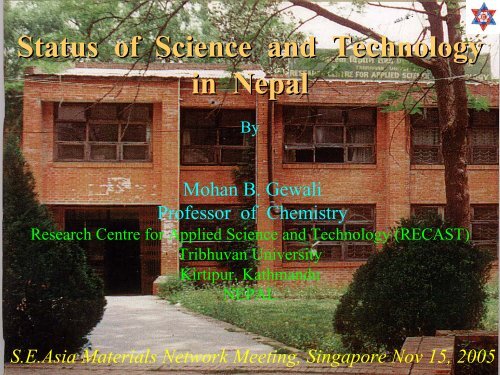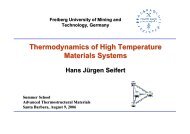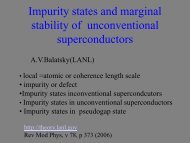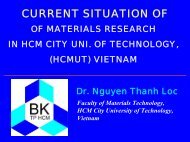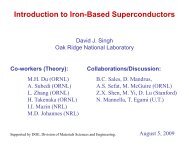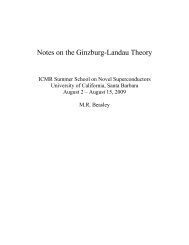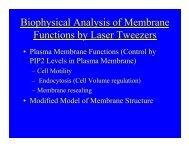Status of Science and Technology in Nepal - ICMR : International ...
Status of Science and Technology in Nepal - ICMR : International ...
Status of Science and Technology in Nepal - ICMR : International ...
Create successful ePaper yourself
Turn your PDF publications into a flip-book with our unique Google optimized e-Paper software.
<strong>Status</strong> <strong>of</strong> <strong>Science</strong> <strong>and</strong> <strong>Technology</strong><br />
<strong>in</strong> <strong>Nepal</strong><br />
By<br />
Mohan B. Gewali<br />
Pr<strong>of</strong>essor <strong>of</strong> Chemistry<br />
Research Centre for Applied <strong>Science</strong> <strong>and</strong> <strong>Technology</strong> (RECAST)<br />
Tribhuvan University<br />
Kirtipur, Kathm<strong>and</strong>u<br />
NEPAL<br />
S.E.Asia Materials Network Meet<strong>in</strong>g, S<strong>in</strong>gapore Nov 15, 2005
<strong>Nepal</strong> at a Glance<br />
• Area:<br />
• Population:<br />
147181sq. Km<br />
25.6 million<br />
• GDP per capita: US$ 240<br />
• Telephone per 100 <strong>in</strong>habitants: 1.26<br />
• Internet users per 10,000 <strong>in</strong>habitants: 25.43<br />
• PC per 100 <strong>in</strong>habitants: 0.34<br />
• Physicians per 10,000 <strong>in</strong>habitants: 4<br />
• Life expectancy:<br />
• Threshold <strong>in</strong>come for poverty l<strong>in</strong>e:<br />
• Population below poverty l<strong>in</strong>e:<br />
• R/D expenditure as % <strong>of</strong> GDP 0.3<br />
• R/D expenditure per capita ( US $) 0.7<br />
59 years<br />
US$ 7.52 per month<br />
around 40% <strong>of</strong> total
A Short History <strong>of</strong> <strong>Science</strong><br />
• Modern science entered <strong>in</strong>to the k<strong>in</strong>gdom with the <strong>in</strong>troduction <strong>of</strong><br />
Intermediate science education <strong>in</strong> Tri-Ch<strong>and</strong>ra college <strong>in</strong> 1919<br />
S<strong>in</strong>ce then Institutions / Policy / Laws<br />
• Bachelor <strong>of</strong> <strong>Science</strong>: Tri-Ch<strong>and</strong>ra College, 1948<br />
• Master <strong>of</strong> <strong>Science</strong>: Tribhuvan University, 1965<br />
• Institutes <strong>of</strong> Medic<strong>in</strong>e, Eng<strong>in</strong>eer<strong>in</strong>g, Forestry, Agriculture, Tribhuvan<br />
University, 1973<br />
• The Sixth Five Year Plan (1980-1985) l<strong>in</strong>k S/T activities with<br />
economic development
S<strong>in</strong>ce then Institutions / Policy / Laws Contd…<br />
• National Council <strong>of</strong> <strong>Science</strong> <strong>and</strong> <strong>Technology</strong> (NCST), 1976 (now<br />
dismantled)<br />
• Research Centre for Applied <strong>Science</strong> <strong>and</strong> <strong>Technology</strong> (RECAST),<br />
1977<br />
• Royal <strong>Nepal</strong> Academy <strong>of</strong> <strong>Science</strong> <strong>and</strong> <strong>Technology</strong> (RONAST), 1982<br />
• M<strong>in</strong>istry <strong>of</strong> <strong>Science</strong> <strong>and</strong> <strong>Technology</strong>, 1995<br />
• Educational Sectors<br />
• Kathm<strong>and</strong>u University<br />
• Purbanchal University<br />
• Pokhara University<br />
• B.P. Koirala Institute <strong>of</strong> Health <strong>Science</strong><br />
• National Academy <strong>of</strong> Medical <strong>Science</strong>s, Bir Hospital
Government Sectors<br />
• National Agriculture Research Centre, 1991<br />
• Department <strong>of</strong> Forest Survey <strong>and</strong> Research, 1963<br />
• Department <strong>of</strong> Irrigation, Hydrology <strong>and</strong> Meteorology, 1967<br />
• Department <strong>of</strong> Plant Resources, 1957<br />
• Department <strong>of</strong> Geology <strong>and</strong> M<strong>in</strong>es, 1958<br />
• Department <strong>of</strong> Soil Conservation, 1974<br />
• National Bureau <strong>of</strong> St<strong>and</strong>ard <strong>and</strong> Metrology, 1976<br />
• Food Research Lab, 1973<br />
• Department <strong>of</strong> Wild Life Conservation<br />
• Department <strong>of</strong> Drug Adm<strong>in</strong>istration, 1976
The Follow<strong>in</strong>g Policies <strong>and</strong> Acts are Put<br />
Forward by HMG <strong>in</strong> the National Development<br />
• Five Year Plans (start<strong>in</strong>g from 1956)<br />
• Industrial Enterprise Act <strong>and</strong> Industrial Policy, 1992<br />
• Foreign Investment <strong>and</strong> <strong>Technology</strong> Transfer Act, 1992<br />
• National science <strong>and</strong> <strong>Technology</strong> Policy, 1989<br />
• National Policy on Technical Education <strong>and</strong> Vocational<br />
Education, 1999<br />
• Forestry Act<br />
• Agriculture Act<br />
• Information <strong>Technology</strong> Policy, 2002<br />
• <strong>Science</strong> <strong>and</strong> <strong>Technology</strong> Policy, 2005<br />
• National Biotechnology Policy ( Forthcom<strong>in</strong>g)
Nation’s s Present-day Commitment<br />
The present Constitution <strong>of</strong> <strong>Nepal</strong> has categorically spelled out the<br />
essence <strong>of</strong> S/T Policy ‘For the total development <strong>of</strong> the country the state<br />
will pursue the policy <strong>of</strong> giv<strong>in</strong>g priority to the development <strong>of</strong> science<br />
<strong>and</strong> technology as well as focus on the development <strong>of</strong> local<br />
technology.’<br />
Furthermore, the Tenth Five Year Plan (2002-2007) 2007) promulgated with<br />
core objective <strong>of</strong> poverty alleviation envisages the follow<strong>in</strong>g strategy <strong>in</strong><br />
S/T sectors:
1. To mobilize natural resources <strong>and</strong> <strong>in</strong>frastructure to the fullest extent<br />
<strong>and</strong> to establish new structures/<strong>in</strong>stitutions <strong>in</strong> the field <strong>of</strong> S/T when<br />
needed<br />
2. To transfer, adapt <strong>and</strong> utilize foreign technologies as per national<br />
need <strong>in</strong>volv<strong>in</strong>g private sectors as well.<br />
3. To establish a work<strong>in</strong>g system <strong>of</strong> competitiveness <strong>in</strong> R/D activities<br />
among scientists, scientific communities <strong>and</strong> scientific <strong>in</strong>stitutions<br />
4. To support economic <strong>and</strong> social development <strong>of</strong> common people by<br />
susta<strong>in</strong>able use <strong>of</strong> resources through development <strong>of</strong> knowledge <strong>and</strong><br />
skill <strong>in</strong> the field <strong>of</strong> S/T<br />
5. To encourage universities, research <strong>in</strong>stitutes <strong>and</strong> scientists to<br />
become more <strong>in</strong>volved <strong>in</strong> research activities <strong>and</strong> to produce high<br />
class manpower <strong>in</strong> S/T by provid<strong>in</strong>g S/T special place <strong>in</strong> university<br />
curriculum
Burn<strong>in</strong>g Issues<br />
A large number <strong>of</strong> S/T <strong>in</strong>stitutions, National policy <strong>and</strong> Acts.<br />
Some follow<strong>in</strong>g questions require answer.<br />
• Why are our <strong>in</strong>stitutions not work<strong>in</strong>g <strong>in</strong> the manner they should ?<br />
• Why are not fruits <strong>of</strong> our S/T activities reach<strong>in</strong>g to the common<br />
people?<br />
• What is the st<strong>and</strong>ard <strong>of</strong> our science education?<br />
• For whom do we make science policies <strong>and</strong> are we even eager to<br />
know that how they are implemented?<br />
• What quality <strong>of</strong> science we have <strong>in</strong> our lab?<br />
• Why can not we translate whatever R/D we have done <strong>in</strong>to<br />
commercial products?<br />
• What roles are expected from scientists, science teachers, policy<br />
makers, law makers <strong>and</strong> decision makers?
<strong>Science</strong>/<strong>Technology</strong> Policies<br />
RONAST <strong>in</strong> 1989 put forward the first ever National <strong>Science</strong> <strong>and</strong><br />
<strong>Technology</strong> Policy.<br />
The policy emphasized on:<br />
• Proper resource utilization <strong>and</strong> development<br />
• <strong>Technology</strong> transfer<br />
• Quality manpower development <strong>and</strong><br />
• Promotion, extension <strong>and</strong> participation <strong>in</strong> S/T development
<strong>Science</strong>/<strong>Technology</strong> Policies Contd…<br />
• Good S/T policy<br />
• Question is <strong>in</strong> last fifteen years how the policy was implemented<br />
• Who will do what is not specified<br />
• S<strong>in</strong>ce 1989, th<strong>in</strong>gs have changed<br />
• S/T policy - 2005 has already been launched
<strong>Science</strong>/<strong>Technology</strong> Policies Contd…<br />
• Go to S/T strategies mentioned <strong>in</strong> the Tenth Five Year Plan<br />
• Implement<strong>in</strong>g agencies need to be identified<br />
• A nation's development <strong>and</strong> prosperity to a large extent are judged by<br />
the status <strong>of</strong> S/T <strong>of</strong> that country<br />
• A scientifically unsophisticated society means less economic<br />
development <strong>in</strong> all sectors<br />
• Japan ( 3.12% <strong>of</strong> GDP), USA (2.65% <strong>of</strong> GDP) spend on R/D <strong>and</strong> are<br />
<strong>in</strong> the highest echelon <strong>of</strong> development<br />
• <strong>Nepal</strong> (0.34% <strong>of</strong> GDP) rema<strong>in</strong>s <strong>in</strong> lowest ladder <strong>of</strong> development<br />
• Lawmakers are well advised to <strong>in</strong>crease R/D share <strong>of</strong> budget pie if<br />
<strong>Nepal</strong> is to progress fast
<strong>Science</strong>/<strong>Technology</strong> Policies Contd…<br />
• Go to S/T strategies mentioned <strong>in</strong> the Tenth Five Year Plan<br />
• Implement<strong>in</strong>g agencies need to be identified<br />
• A nation's development <strong>and</strong> prosperity to a large extent are judged by<br />
the status <strong>of</strong> S/T <strong>of</strong> that country<br />
• A scientifically unsophisticated society means less economic<br />
development <strong>in</strong> all sectors<br />
• Japan ( 3.12% <strong>of</strong> GDP), USA (2.65% <strong>of</strong> GDP) spend on R/D <strong>and</strong> are<br />
<strong>in</strong> the highest echelon <strong>of</strong> development<br />
• <strong>Nepal</strong> (0.34% <strong>of</strong> GDP) rema<strong>in</strong>s <strong>in</strong> lowest ladder <strong>of</strong> development<br />
• Lawmakers are well advised to <strong>in</strong>crease R/D share <strong>of</strong> budget pie if<br />
<strong>Nepal</strong> is to progress fast
<strong>Science</strong>/<strong>Technology</strong> Policies Contd…<br />
• We lack an <strong>in</strong>stitution to fund research organizations <strong>and</strong> research<br />
projects<br />
• Some sort <strong>of</strong> National <strong>Science</strong> Foundation<br />
• Formulates what type <strong>of</strong> research the country needs <strong>in</strong> l<strong>in</strong>e with<br />
national S/T policy<br />
• Sets priority <strong>in</strong> research<br />
• Identifies the relevant <strong>in</strong>stitutions<br />
• Advertise for the submission <strong>of</strong> research proposals<br />
• Monitors the research<br />
• Makes funds available for research<br />
• Foundation extends h<strong>and</strong>s to government, bus<strong>in</strong>ess communities <strong>and</strong><br />
private endowments to generate resources for do<strong>in</strong>g useful research
<strong>Science</strong> <strong>and</strong> <strong>Technology</strong> Policy 2005<br />
Objectives<br />
• To enhance national capability by develop<strong>in</strong>g <strong>and</strong> utiliz<strong>in</strong>g<br />
knowledge, skill <strong>and</strong> competence <strong>in</strong> the field <strong>of</strong> <strong>Science</strong> <strong>and</strong><br />
<strong>Technology</strong><br />
• To contribute <strong>in</strong> the reduction <strong>of</strong> poverty by improv<strong>in</strong>g economic <strong>and</strong><br />
social condition <strong>of</strong> the people at large through susta<strong>in</strong>able use <strong>of</strong><br />
natural resources <strong>and</strong> means <strong>and</strong> conservation <strong>of</strong> the environment<br />
• To take the nation <strong>in</strong> competitive advantage by utmost development <strong>of</strong><br />
<strong>Science</strong> <strong>and</strong> <strong>Technology</strong><br />
It focuses on:<br />
• Infrastructure development<br />
• Human resource development<br />
• R & D
Vision:<br />
To build the country as a developed,<br />
dynamic <strong>and</strong> prosperous state by<br />
rais<strong>in</strong>g the liv<strong>in</strong>g st<strong>and</strong>ards through<br />
the appropriate development <strong>and</strong> use<br />
<strong>of</strong> science <strong>and</strong> technology.
MISSING POINTS<br />
• INSTITUTIONS ARE NOT IDENTIFIED<br />
• SILENT ON EXENDITURE ON R <strong>and</strong> D ( atleast 1% <strong>of</strong> GDP)<br />
• NOT MUCH ABOUT YOUNG SCIENTISTS<br />
• COORDINATION OF SCIENCE RELATED ORGANIZATIONS<br />
• NATIONAL INNOVATION SYSTEM<br />
– <strong>in</strong>stitutions that contribute to the creation, diffusion <strong>and</strong> use <strong>of</strong> new<br />
economically useful knowledge <strong>and</strong> the l<strong>in</strong>kages <strong>and</strong> synergies between the<br />
<strong>in</strong>stitutions<br />
– <strong>in</strong>stitutes <strong>in</strong>clude universities, research centres, Government , f<strong>in</strong>ancial <strong>and</strong><br />
<strong>in</strong>dustrial houses <strong>and</strong> <strong>in</strong>volves technical, commercial, legal, developmental, social ,<br />
f<strong>in</strong>ancial, <strong>and</strong> regulatory mechanisms<br />
– R <strong>and</strong> D, developments <strong>of</strong> products, commercialisation <strong>and</strong>market<strong>in</strong>g, to spur<br />
<strong>in</strong>novation<br />
– this network is the foundation <strong>of</strong> NATIONAL INNOVATION SYSTEM
<strong>Science</strong>/<strong>Technology</strong> Organizations<br />
Two General Comments<br />
• <strong>Nepal</strong>i S/T <strong>in</strong>stitutions have m<strong>in</strong>imum or no coord<strong>in</strong>ation with other<br />
organizations.<br />
• Organizations lack clear-cut mission <strong>and</strong> objectives so that works <strong>and</strong><br />
activities are duplicated withst<strong>and</strong><strong>in</strong>g resource constra<strong>in</strong>ts
<strong>Science</strong>/<strong>Technology</strong> Organizations Contd..<br />
• Teach<strong>in</strong>g <strong>in</strong>stitutions play key role <strong>in</strong> produc<strong>in</strong>g well qualified<br />
manpower<br />
• Some good news: our graduates are <strong>in</strong>ternationally sellable<br />
• Some faculty members do<strong>in</strong>g good piece <strong>of</strong> research work published<br />
<strong>in</strong> journal <strong>of</strong> <strong>in</strong>ternational repute<br />
• Research <strong>in</strong>frastructure <strong>of</strong> Tribhuvan University pr<strong>of</strong>usely upgraded,<br />
thanks to a World Bank assistance<br />
• Ph. D. programme is weak. Without a sound Ph.D program, research<br />
can not be susta<strong>in</strong>ed
<strong>Science</strong>/<strong>Technology</strong> Organizations Contd..<br />
• Programs designed to enhance teacher's ability, motivation <strong>and</strong><br />
confidence lack<strong>in</strong>g<br />
• A few Ph. D.scholarships for teachers are available.<br />
• Some talented teachers go abroad for Ph. D., but chances <strong>of</strong> return <strong>and</strong><br />
serve the country are becom<strong>in</strong>g more <strong>and</strong> more slim<br />
• They can not quench the thirst <strong>of</strong> do<strong>in</strong>g <strong>in</strong>novative research due to<br />
lack <strong>of</strong> research <strong>in</strong>frastructure<br />
• Some compla<strong>in</strong> that their expertise <strong>and</strong> skill are not recognized <strong>in</strong><br />
their country
<strong>Science</strong>/<strong>Technology</strong> Organizations Contd..<br />
• Bra<strong>in</strong> dra<strong>in</strong> is a big problem<br />
• The other side <strong>of</strong> the co<strong>in</strong> is equally <strong>in</strong>terest<strong>in</strong>g. We lack<br />
adm<strong>in</strong>istrative mechanism to reta<strong>in</strong> good People.<br />
• In the academic research front, faculty member are do<strong>in</strong>g research<br />
on their own <strong>in</strong>itiatives <strong>and</strong> for their pleasure <strong>and</strong> satisfaction<br />
• The po<strong>in</strong>t to stress is research has not become <strong>in</strong>tegral part <strong>of</strong><br />
academic life<br />
• University must be made hob <strong>of</strong> research activities<br />
• Importance <strong>of</strong> University research
<strong>Science</strong> <strong>and</strong> Society<br />
Scientific culture<br />
• Openness<br />
• Devotion to the scientific work<br />
• Transparency <strong>in</strong> their work<br />
• Shar<strong>in</strong>g <strong>of</strong> knowledge <strong>and</strong> expertise with others<br />
• Nonhierarchical system <strong>of</strong> work<strong>in</strong>g
<strong>Science</strong> <strong>and</strong> Society<br />
• In addition to enrichment <strong>of</strong> state <strong>of</strong> knowledge, fruits <strong>of</strong> R & D<br />
should also reach common people<br />
• <strong>Technology</strong> as knowledge <strong>of</strong> how to fulfill human purposes <strong>in</strong> a<br />
specifiable <strong>and</strong> reproducible way<br />
• Component <strong>of</strong> <strong>Technology</strong> Development <strong>and</strong> Transfer<br />
• The hardware (equipment) development<br />
• The means <strong>of</strong> produc<strong>in</strong>g, distribut<strong>in</strong>g, <strong>in</strong>stall<strong>in</strong>g, ma<strong>in</strong>ta<strong>in</strong><strong>in</strong>g<br />
<strong>and</strong> repair<strong>in</strong>g the equipment<br />
• The ongo<strong>in</strong>g social preparation <strong>and</strong> end-use tra<strong>in</strong><strong>in</strong>g required<br />
for the equipment to be used effectively<br />
• Institutions <strong>and</strong> mechanism for f<strong>in</strong>anc<strong>in</strong>g end-users,<br />
distributors, local manufacturers <strong>and</strong> others
<strong>Science</strong> <strong>and</strong> Society Contd…<br />
• Unless these factors are taken care <strong>of</strong>, technology transfer will not be<br />
successful<br />
• Some successes: Rural <strong>Technology</strong>, RETs<br />
• Suffers from<br />
• Limited application<br />
• Usually supply side technology<br />
• Inadequate awareness <strong>and</strong> tra<strong>in</strong><strong>in</strong>g program<br />
• Incoherent subsidy <strong>and</strong> other policies
There appears to be m<strong>in</strong>imum <strong>in</strong>volvement <strong>of</strong> bus<strong>in</strong>ess<br />
community <strong>and</strong> entrepreneurs <strong>in</strong> R <strong>and</strong> D activities<br />
• Scientists lack entrepreneurial skill<br />
• Bus<strong>in</strong>ess community does not dialogue with scientists<br />
• What can be done <strong>in</strong> such situation?<br />
• Solution: <strong>Technology</strong> Incubators?<br />
The <strong>in</strong>cubator concept may have the follow<strong>in</strong>g elements:<br />
• A technological laboratory act<strong>in</strong>g as a source <strong>of</strong> <strong>in</strong>novations<br />
• Investment funds for seed capital <strong>and</strong><br />
• An <strong>in</strong>cubator facility located next to the laboratory<br />
The IT park at Banepa may also act as some sort <strong>of</strong> <strong>in</strong>cubator
What Needs to be Done<br />
• As outl<strong>in</strong>ed <strong>in</strong> the Tenth Five Year Plan, it is extremely important<br />
that its S/T activities be directed towards poverty reduction. In order<br />
to channelize R/D activities <strong>in</strong> l<strong>in</strong>e with national policies, <strong>Nepal</strong><br />
<strong>Science</strong> <strong>and</strong> <strong>Technology</strong> Foundation must be created for attract<strong>in</strong>g<br />
<strong>and</strong> dissem<strong>in</strong>at<strong>in</strong>g funds for do<strong>in</strong>g S/T activities. National Research<br />
Laboratories on different area <strong>of</strong> S/T should gradually be established.<br />
• <strong>Science</strong> education needs qualitative improvement. Ph.D. <strong>and</strong> Master<br />
programs should be strengthened. Special <strong>and</strong> <strong>in</strong>tensive science<br />
education should be started <strong>in</strong> schools selected on the basis <strong>of</strong><br />
school's capability <strong>and</strong> performance. In order to utilize young<br />
scientists <strong>in</strong> creative activities <strong>and</strong> also to prevent bra<strong>in</strong> dra<strong>in</strong>, a<br />
scheme <strong>of</strong> pool scientists <strong>in</strong> which they work <strong>in</strong> assigned S/T<br />
organizations for a fixed period <strong>of</strong> time dur<strong>in</strong>g which they are<br />
expected to f<strong>in</strong>d tenured position <strong>of</strong> their choice, needs to be<br />
established.
What Needs to be Done Contd…<br />
• One irony is that scientific organizations possess expensive<br />
<strong>in</strong>struments <strong>and</strong> equipments that are not used, underused or out <strong>of</strong><br />
order for small reason. A <strong>in</strong>ventory <strong>of</strong> such <strong>in</strong>struments should be<br />
made <strong>and</strong> maximum utilization <strong>of</strong> such <strong>in</strong>struments should be<br />
ensured. We would th<strong>in</strong>k that M<strong>in</strong>istry <strong>of</strong> <strong>Science</strong> <strong>and</strong> <strong>Technology</strong><br />
should take lead on this.<br />
• A mechanism <strong>of</strong> <strong>in</strong>volv<strong>in</strong>g bus<strong>in</strong>ess people <strong>and</strong> entrepreneurs <strong>in</strong><br />
support<strong>in</strong>g R/D activities should be established. Bus<strong>in</strong>ess <strong>in</strong>cubators<br />
need to be established <strong>in</strong> order to convert R/D <strong>in</strong>ventions <strong>in</strong>to<br />
commercial products. Indigenous technologies need to be<br />
strengthened <strong>and</strong> modified, if necessary, to meet the country’s<br />
dem<strong>and</strong>s. Imported technologies should be made country suitable<br />
through adaptive research.
What Needs to be Done Contd…<br />
• In view <strong>of</strong> globalization <strong>and</strong> <strong>Nepal</strong>'s entry <strong>in</strong> WTO, effective<br />
mechanism needs to be developed to safeguard traditional<br />
knowledge, skill, problem solv<strong>in</strong>g ability <strong>and</strong> biodiversity <strong>and</strong> IPR.<br />
At the same time, area <strong>of</strong> our competitive advantages need to be<br />
identified <strong>and</strong> priority for R/D activities <strong>in</strong> such area should be<br />
ensured.
Thank You!


